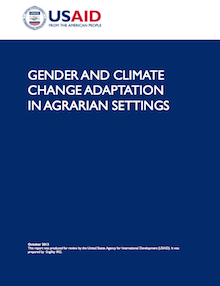Gender and Climate Change Adaptation in Agrarian Settings


The vast majority of work on gender and climate change adaptation treats gender as a simple either/or binary with men on one side and women on the other. This report, however, shows that approaching gender analysis through this binary approach alone is out of step with the current state of knowledge on gender and adaptation. Further, using empirical evidence drawn from field research in rural agricultural settings in Ghana, Mali, and Malawi, the report demonstrates the challenges that binary gender analyses have in properly identifying (and therefore addressing) the problems vulnerable populations are facing. Instead, the research in this report suggests that adaptation interventions would benefit from a more nuanced approach that examines how gender identity intersects with other social identities, such as age, livelihood/class, and ethnicity to determine vulnerabilities to climate variability and change.
Barriers to overcome vulnerability
An incomplete understanding of all aspects of vulnerability is likely to lead to adaptation interventions that fail to appropriately address vulnerability, do not deliver the maximum possible benefits, and may even leave some members of society worse off.
Major findings from report
First, the identity categories most relevant to understanding vulnerability in a particular place are contextually specific. In the Ghana case, it was the intersection of gender with livelihoods strategies and household situation that brought out the identities most responsible for the production of different livelihoods vulnerabilities to climate change impacts. In the Mali case, the salient intersection was gender and seniority. In Malawi, distinct and differentiated vulnerabilities within gender groups only become visible when gender is understood in the context of the village of residence, and its proximity to the unique livelihoods opportunities and resources in the MMFR.
Second, the use of binary gender analysis to explore vulnerability to climate change impacts risks glossing over important intra-community and intra-household vulnerabilities, including those of the most marginal and vulnerable. For example, in the Ghana case, it is very difficult to identify and address the specific livelihoods vulnerabilities of women in female-headed households, and women in diversified households, via a binary gender analysis, as such analysis aggregates the situations of all women into something that most resembles the situations of women in market households, the most secure members of the community. In the Mali case, binary gender analysis suggest gendered patterns of livelihoods activities that, in fact, are produced through specific intersections of seniority and gender. For example, a vulnerability analysis built on this generalized pattern would overlook the specific vulnerabilities and capacities of senior men in this cluster by ignoring their gardening activities. In Malawi, a binary analysis of gender suggests that vulnerability is evenly distributed across the married study population (though women heading households have some distinct vulnerabilities, due to their different livelihoods activities). Yet there are distinct and differentiated vulnerabilities within married households that are tied first to location, and then to gendered emphases with regard to crop selection and livelihoods activities.
The legacy of gender and development research and implementation is an enhanced sensitivity to the role of social difference in the production of vulnerability and adaptive capacity. By moving beyond a narrow focus on gender to a treatment of gender as a key part of the many different, contextually-specific identities that inform the decisions and outcomes that shape the world of the global poor each day, we can better identify and address the challenges that climate change and poverty present, now and in the future.
USAID is planning to conduct focused pilot efforts over the next few years that put these findings into practice and provide evidence for the tangible benefits of taking a more nuanced approach to gender in climate change adaptation planning and implementation.
Report prepared by:
United States Agency for International Development,
Authors: Edward R. Carr, Society, Environment, Economy Group, LLC Columbia;Department of Geography, University of South Carolina Columbia, and Mary C. Thompson,Biodiversity International/ Basque Center for Climate Change Alameda Urquijo 4, Bilbao Bizkaia, Spain.
Published October 2013, USAID, Washington, USA.
(0) Comments
There is no content